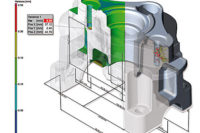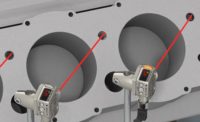Recent advances in scanning electron microscopy (SEM), particularly in the benchtop realm, enhance quality control procedures of laboratories across a wide range of industries. From semiconductors to pharmaceutical manufacturing, SEMs play a critical role in the analysis of products. The availability of compact benchtop SEMs allows companies to perform analyses in their own laboratories in as little as 15 minutes, saving time and money.
A scanning electron microscope reveals information about changes in microscopic properties of particles. This information may include chemical composition, crystalline structure, morphology, and contaminant identification.
SEMs are often used in conjunction with energy dispersive X-ray spectrometry (EDS) for mapping and for contamination analysis. With their small size, benchtop SEMs allow well-trained quality employees to quickly compare suspect contaminants to reference samples collected from the manufacturing process, reducing turnaround times. These SEMs are also advantageous in addressing customer complaints; for example, trained microscopists can use a benchtop SEM to successfully identify the origin of foreign matter to determine a claim’s validity.
The majority of the quality control work performed is the examination of size and shape of particles, for example, which constitute a bulk powder for pharmaceuticals, or micron-sized components of semiconductors and semiconductor polishing pads. Two types of signals are produced by a SEM: secondary electrons (SE), and back-scattered electrons (BSE). SE imaging can produce high-resolution images of the sample surface, often less than one nanometer in size. Since the intensity of the BSE signal is closely related to the atomic number of the sample, BSE imaging is particularly useful in providing information about the distribution of different elements within the sample. These types of analyses are useful in many situations; for example, to determine not only whether products meet acceptance limits, but after inspection, to improve ongoing product quality and process improvement by monitoring trends. When products are out of acceptable limits, on-line SEM analysis can aid investigations.
Previously, most benchtop SEMs were low-vacuum instruments because many materials are non-conductive, as well as vacuum and beam sensitive. In addition, earlier benchtop units were restricted to one accelerating voltage, thereby limiting resolution capability. Current advancements have created benchtop SEMs with as many as three accelerating voltages, both high and low-vacuum modes, and the capability of detecting secondary and back-scattered electrons. These added features allow the user to analyze a wider range of samples, and achieve higher-resolution images.
Maximum specimen size and total sample travel range are equally important. While some full scale SEMs allow for samples as large as a shoe to be analyzed, earlier benchtop versions only allowed for samples up to 25 millimeters (mm) in diameter. Newer benchtop SEMs accommodate samples up to 70 mm in diameter and 50 mm thick. These relaxed size limitations decrease sample preparation time—a key component of scanning electron microscopy, and allow for a greater array of samples to be analyzed.
Overall instrument size matters, and in this case, the smaller, the better. In the past, entire laboratory rooms were necessary to accommodate the larger footprint of a full scale SEM. Other factors that needed to be considered to ensure the overall functionality of the instrument included the thickness of the floor (the SEM is a very sensitive instrument; the slightest vibration can have an impact on imaging), and ensuring that electrical fields around the instrument were minimized. Current benchtop SEMs are as small as 20” by 18” by 17” and weigh as little as 100 pounds. Quality control laboratories have realized the benefit of placing these conveniently-sized instruments right into their optical microscopy labs, and right onto existing benchtops.
The moment a scientist can “see” something is the moment they are working towards. Magnification allows microscopists to see what they could not see before, and the greater the magnification, the greater the chance they will see their area of interest. The magnification capability of the SEM influences the amount of information revealed about changes in microscopic properties of particles; for example, material anomalies in a steel spring that could cause it to fail, microscopic particles on a semiconductor that could induce a short, or incompatible materials used in automotive paint that cause it to flake. Quality control scientists are interested in size and shape analysis and contaminant identification, and the greater the magnification they can achieve, the better. Current benchtop SEMs offer greater magnification ranging from 10X up to 60,000X, with resolution capabilities of 30 nanometers. Truly, viewing a particle of interest has been simplified as a result of benchtop SEM technology advancements.
Abilities to perform elemental identification both on the product itself and on contaminants that may be present are equally valuable. EDS is a technology that, until recently, was only found on large-scale instruments. Current benchtop instruments are equipped with fully-integrated silicon drift detectors (SDD), delivering complete elemental analysis. With the push of a button, users can create quantitative elemental maps, generate spectral data, and determine relative concentration changes. These new abilities, right “on the bench,” allow scientists to fully analyze their specimens and receive instant data.
Quality control laboratories’ newfound ability to perform quick, qualitative observations in-house is helpful for risk prevention. A slight change in any source material’s morphology can affect a final product’s safety, and additionally in pharmaceuticals, their efficacy. The sleek product designs and greater analytical capabilities of current instruments allow quality labs to quickly and accurately image samples before and after a variety of tests, at varying time increments. By monitoring any changes, the data can be immediately used to refine the manufacturing process to prevent similar changes from occurring in the future.
Benchtop SEM controls have been simplified, and units are now available with touchscreen interfaces. While training on any new instrument is always recommended, operators with experience in SEM particle analysis adapt easily to the controls of the new, diminutive SEMs.
Benchtop SEMs enable scientists to perform immediate quality control analysis. The instrument’s ease-of-use and compact size, coupled with the variety of samples that can be analyzed and the ability to obtain detailed, speedy results, secure it as an efficient and cost-saving addition to a quality control laboratory.





